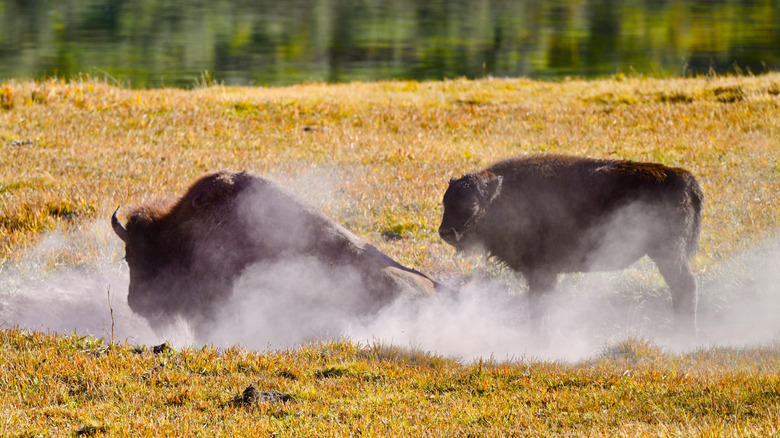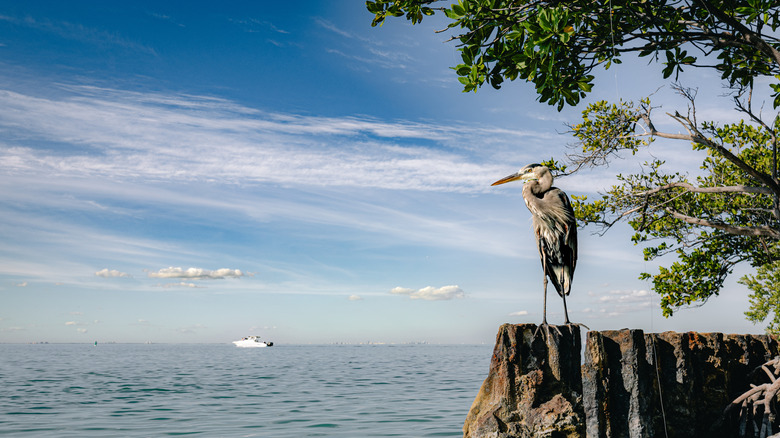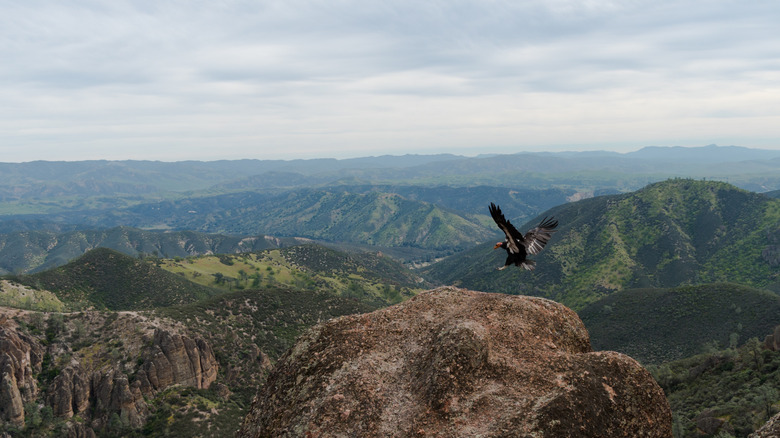The 5 Best American National Parks For Spotting Rare And Endangered Wildlife
America's national parks protect some of the most well-preserved wilderness and ecosystems in the world. As a result, many national parks are also excellent destinations for wildlife watching. Vast woodlands, vibrant coastlines, and even arid deserts found in these areas all protect a rich diversity of animal life, with a comprehensive range of mammals, birds, reptiles, and sea creatures making frequent appearances. Some sites even offer wildlife cams that let you observe their resident animals from your own computer! However, this diversity of life has a tragic side: Many national parks are designated as such to preserve rare and/or threatened ecosystems, as plenty of the animals that they protect are unfortunately at risk of being or are already endangered.
You can, of course, see rare or endangered species outside of a national park (for example, North Carolina's Sylvan Heights Bird Park has the world's largest collection of rare waterfowl). Yet National Park Service-administered sites usually offer the best chances to witness these amazing animals in their natural habitats. Even better, dedicated conservationists, scientists, and other professionals of the National Park Service (plus federal partners like the U.S. Fish & Wildlife Service) do an incredible job in rehabilitating and protecting endangered species populations through critical initiatives like the National Park Service's At-Risk Species Program.
And while you may come across such species in just about any U.S. national park, a few stand out above the rest. Some parks are particularly notable for being home to populations of rare, threatened, or endangered species. These spots offer the best opportunities for you to see these at-risk animals in the wild.
Biscayne National Park
Florida's subtropical climate and blend of wetlands and coastal regions create some of the most unique ecosystems in the mainland United States to go with its three amazing national parks. The Everglades is the most famous of Florida's national parks, with its immense population of alligators and iconic airboat tours. However, the lesser-known Biscayne National Park offers arguably an even better experience of Florida's one-of-a-kind flora and fauna, including several rare and endangered species. Though it sits just off the coast of the vibrant city of Miami, Biscayne National Park is an overlooked natural gem and one of Florida's best-kept secrets.
Much of Biscayne's naturalistic appeal stems from the fact that most of the park is underwater, with a few smatterings of islands accessible only by boat. This marine environment provides Biscayne with a rich network of coral reefs and coastal mangrove forests sitting at the intersection of four distinct ecosystems, all teeming with eye-catching sea life. A uniquely fertile network of ecosystems also means a better chance of seeing rare animals than anywhere else in Florida.
The most notable of Biscayne National Park's endangered residents are perhaps its population of sea turtles. Biscayne is home to several species of sea turtles, including the endangered loggerhead, hawksbill, and leatherback turtles. Not only does Biscayne provide a safe haven and dedicated conservation efforts for these threatened species, but it also offers excellent turtle viewing opportunities (from a safe distance) along one of its many snorkeling and scuba diving spots. Biscayne is also home to rare marine mammals, most notably the lovable but vulnerable West Indian manatee. And while Biscayne's Florida wetlands obviously contain numerous alligators, the park is also home to the much rarer American crocodile, which you might see chilling around the park.
Channel Islands National Park
On the opposite coastline from Biscayne, California's Channel Islands National Park protects a different, but equally valuable, coastal ecosystem. Also like Biscayne, Channel Islands is deceptively close to a major urban area — in this case, the vast metropolis of Los Angeles. However, the several islands that comprise the park take advantage of their isolated geography to hold off any encroaching development or infrastructure. As a result, Channel Islands National Park has one of the state's most unique coastal ecosystems, with populations of animals found nowhere else on Earth.
The Channel Islands sit within Southern California's coastal Mediterranean-esque ecosystem, at the convergence of two ocean currents. Similar to Biscayne's, this distinctive environment provides Channel Islands National Park with rich marine, coastal, and terrestrial habitats for a diverse abundance of animal life. The Pacific waters surrounding the islands are excellent for viewing magnificent marine mammals, including whales (most notably gray whales, humpback whales, and blue whales), sea lions, seals, dolphins, and sea otters. However, the park's rarest animal inhabitant actually resides in its terrestrial environment.
Six of the eight Channel Islands are home to the incredibly rare island fox, a relative of the mainland gray fox that evolved into a separate species after eons of island isolation. Wild island foxes are only found within the Channel Islands, so if you're lucky enough to see one during your trip, you're getting a gift that no one else in the world can claim! Sadly, invasive species and diseases have led to a severe decline in island fox populations. The good news, though, is that the national park has undertaken intensive island fox rehabilitation programs in recent years, leading to an increase in monitored fox populations and fewer threats going forward.
Pinnacles National Park
California's nine national parks are the most of any single state. This sometimes causes lesser-known California parks to be overshadowed by their more famous neighbors. While sites like Yosemite and Joshua Tree are iconic, other treasures like Pinnacles National Park fly too far under the radar. This is a shame, because the underrated Pinnacles National Park is an astounding preserve of incredible caves and diverse trails, all backed by a geological landscape that doesn't quite look like anywhere else on Earth.
Pinnacles National Park boasts the remnants of a massive volcanic field that violently shaped the landscape around 23 million years ago. Erosion eventually carved the volcano's ruins into a series of towering rocky pinnacles that preside over the California landscape, just east of the Salinas Valley. The Mediterranean climate of central California fostered a complex physical environment, where lush green hills meet dramatic volcanic monoliths.
Pinnacles' namesake features certainly make the park an unforgettable spectacle to behold. However, the national park serves another crucial purpose beyond its geological heritage. Since 2003, Pinnacles has partnered with the California Condor Recovery Program to act as a critical release and management site for captive-bred birds. California condors, the largest land birds in North America, were once abundant across the West Coast. Unfortunately, habitat destruction, pollution, and other human-caused factors caused a dramatic population decline. The species hit its nadir in the 1980s, when there were only 22 wild condors identified. Dedicated conservation efforts have since brought this endangered species back from the brink, with Pinnacles playing a major role in the condor's comeback story. Today, visitors to Pinnacles can witness these incredible birds soaring over the park's rocky towers — complete with tracking tags that can help you identify them!
Death Valley National Park
A park named "Death Valley" seems like the last place you'd find a thriving population of animal life, especially not any threatened or endangered species. Names (and looks) can be deceiving, however. Death Valley National Park is actually home to a strikingly diverse community of plants and animals. Death Valley itself is a deep basin in the Mojave Desert, featuring the lowest points in North America and some of the hottest temperatures ever recorded. Yet, despite extreme conditions, Death Valley is a lush part of the larger Mojave and Colorado Desert Biosphere, with hardy plants and animals to prove it.
The rarest animal you might encounter in Death Valley is the threatened desert tortoise. While its range extends through much of Southern California and parts of Nevada, Arizona, and Utah, the desert tortoise is unfortunately facing several threats, most notably habitat destruction and invasive species. Declining desert tortoise populations could have devastating effects on the entire Mojave ecosystem, making their conservation all the more critical. Death Valley National Park provides much-needed protection for these remarkable animals, though they do face risk from vehicle collisions. When driving through the park, always watch out for the desert tortoise's distinctive domed, patterned shells along the roads.
Death Valley National Park does have another extremely rare species that's not quite as "on view" as the desert tortoise. An underground lake in Death Valley's detached Devils Hole unit in Nevada serves as home to one of the world's rarest fish. The Death Valley pupfish is only found in this 215-square-foot subterranean pool. And though the pupfish is much harder to see than the desert tortoise (as its lake home is in a fenced-off cave), you can still enjoy the knowledge that so rare a fish is swimming below your feet!
Yellowstone National Park
Yellowstone National Park is the most famous national park in the United States (and arguably the world), partly because of its incredible diversity of wildlife. The Greater Yellowstone Ecosystem is one of the largest intact temperate-zone ecosystems on the planet, with an abundance of forests, mountains, and waterways to support a rich tapestry of plants and animals. This vast ecosystem, when combined with the protection provided by the National Park Service, makes Yellowstone a top place for viewing large and charismatic fauna not often seen in the lower 48 states.
Among Yellowstone's most important animal populations is America's largest bison herd. Although the American bison is today an emblematic symbol of the nation's rugged spirit (and the official national mammal of the United States), bison populations faced near extinction just a century ago. American bison have thankfully come back from the edge, but Yellowstone stands out for showcasing how bison once existed before their near extinction at the hands of humans. Yellowstone's bison herd is the only one in the U.S. to exist continuously since prehistoric times, and the park's vast size and protected status mean that its herdmembers can graze, migrate, and explore in ways that smaller herds in other parks cannot. And despite (reasonable) restrictions on approaching or touching bison, Yellowstone remains the best place to see these animals in the wild.
Other than bison, Yellowstone is one of the best places in the lower 48 states to see wild gray wolves. Reintroduced to the park in 1995, Yellowstone's wolves now number in the hundreds and play a major role in maintaining the park's delicate ecosystem. Grizzly bears, lynxes, wolverines, and other animals rarely seen in the contiguous U.S. also make their homes in Yellowstone's vast and rich ecosystem.





